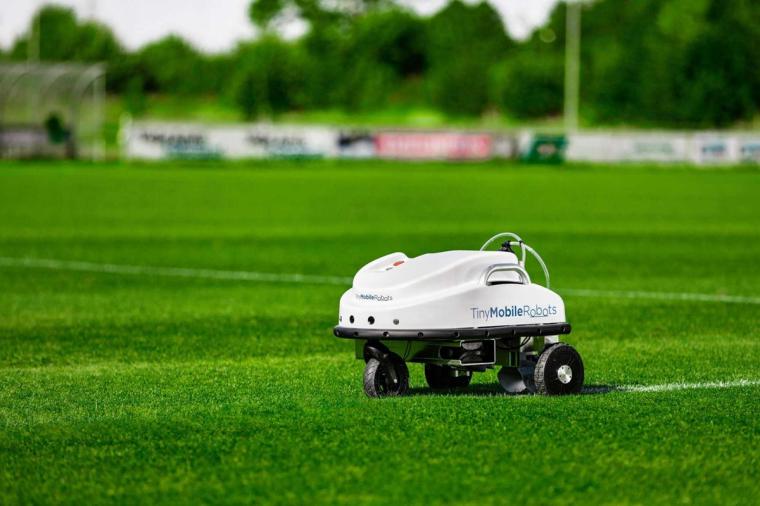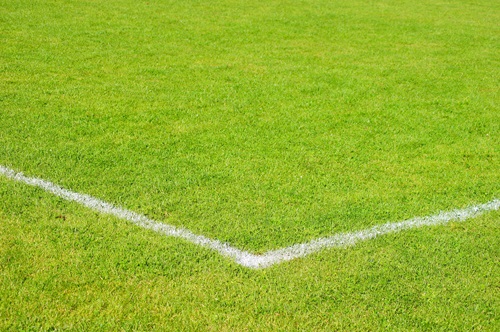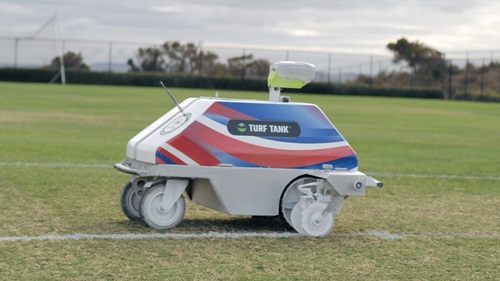
Remember when grass field venue managers had to spend times (prior to every single tournament) marking fields with a measuring wheel, string and chalk dust?
Those days are gone.
Thanks to robotic lining systems, fields are now able to be marked easily and precisely in under two hours (often under 30 minutes), at a time and labor savings of 90 percent. The autonomous devices employ GPS technology to do the job, using the field's coordinates to drive along the grass and leave accurate lines of paint to create yard lines, hash marks, numbers and everything in between. (It can even add special marks, such as pink breast cancer ribbons, should those be needed.)
Better living through technology, right?
Well – not everyone agrees on that but in the meantime, here are the facts. Robotic line marking systems are available through a number of manufacturers, both inside and outside the U.S. A video showing how one system works can be found here.
In addition to their labor-saving qualities, the new marking systems have pinpoint accuracy. And precision is important, after all; a matter of inches can make an enormous difference in the outcome of a game. Robotic line markers claim to be able to put markings on all fields that are accurate to within 1 cm.
 Additionally, robotic line markers can be pre-loaded with templates for a wide array of fields; in some cases, more than 100 field patterns are available, meaning fewer trips to the web to visit the sites of governing bodies and rules organizations in order to look up diagrams.
Additionally, robotic line markers can be pre-loaded with templates for a wide array of fields; in some cases, more than 100 field patterns are available, meaning fewer trips to the web to visit the sites of governing bodies and rules organizations in order to look up diagrams.
But while robotic field markers may be the wave of the future, there are those who are less than impressed with them. To them, it’s like, well, watching paint dry.
“How boring is that? Pretty boring to me,” David Webster, a field marking general for 23 years, told Queen City News.
Because of the rise of the machines, some of Webster’s longtime clients informed him they no longer needed his services.
“’I’ve got a robot now, appreciate what you’ve done all these years but…’ And I’ll say, ‘Fine, go for it,’” said Webster.
When one blogger shared a video of a line-marking robot on social media, it racked up millions of views and thousands of comments.
“That’s my old groundsman job replaced, unbelievable; glad I’m retired,” one man said.
“This is going to remove so many jobs,” another said.
“Make someone’s job easier? More likely that person’s job has just been replaced,” said a third.
In other cases, however, field managers say that the robots, which can do jobs that formerly consumed several hours out of the day, allow venues to redistribute their workers to take care of the fine-tuning of fields, and to address problems like inspections and repairs. (Where, by the way, drones are being employed to help give a good overhead view of overall condition of fields, as seen by even grass color and lack of imperfections.)
Within the marketplace itself, the robotic systems are making their mark. Denmark-based TinyMobileRobots and the National Federation of State High School Associations (NFHS) have announced a new partnership, making TinyMobileRobots the official and exclusive robotic line painting partner of the NFHS.
 , another line-marking robot built specifically for lining athletic fields, has seen success in a variety of installations as well.
, another line-marking robot built specifically for lining athletic fields, has seen success in a variety of installations as well.
“To date, we’ve got more than 1,200 robots painting fields across the U.S. and more than 1,500 globally,” Turf Tank Chief Marketing Officer Simon Christensen told reporters at Inside Unmanned Systems. “The majority of our U.S. robots are at schools and local parks and recreation departments, but we also have a number of major colleges and universities, including LSU, Alabama, Clemson and Michigan. We have two NFL stadiums, Paul Brown Stadium in Cincinnati and Raymond James Stadium in Tampa, and we have a few MLS teams.”
Because autonomous line marking systems represent a significant investment, it is not uncommon for several organizations to pool their resources in order to buy one. Additionally, some manufacturers offer options for leasing the equipment.

